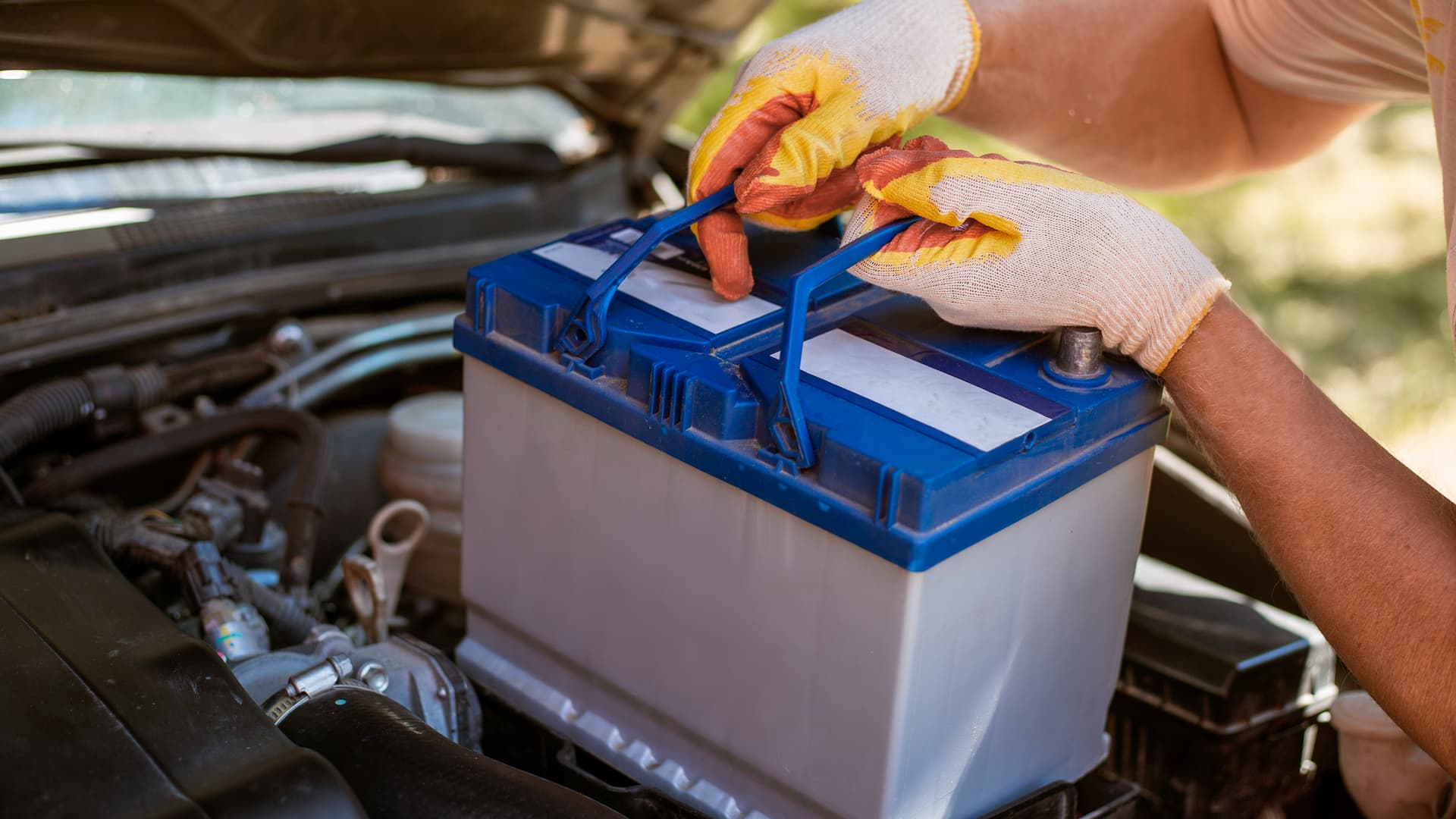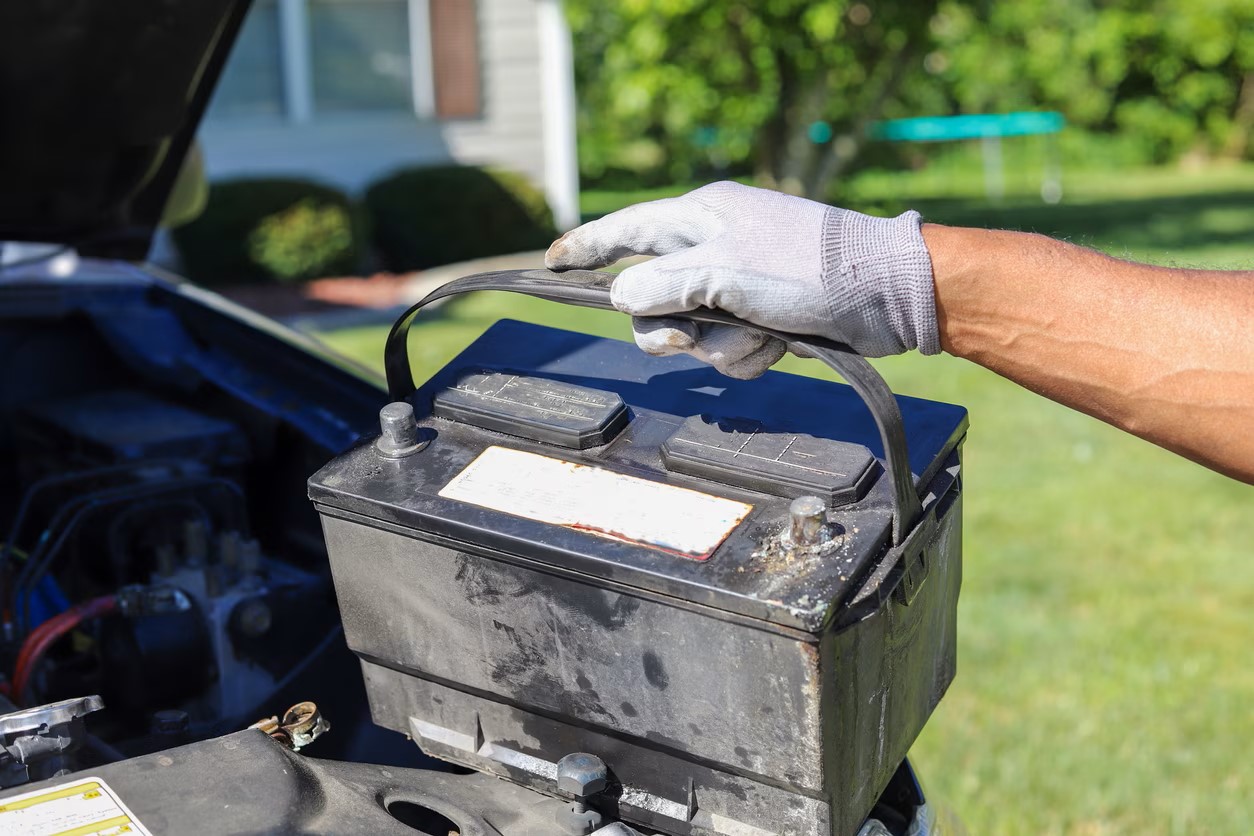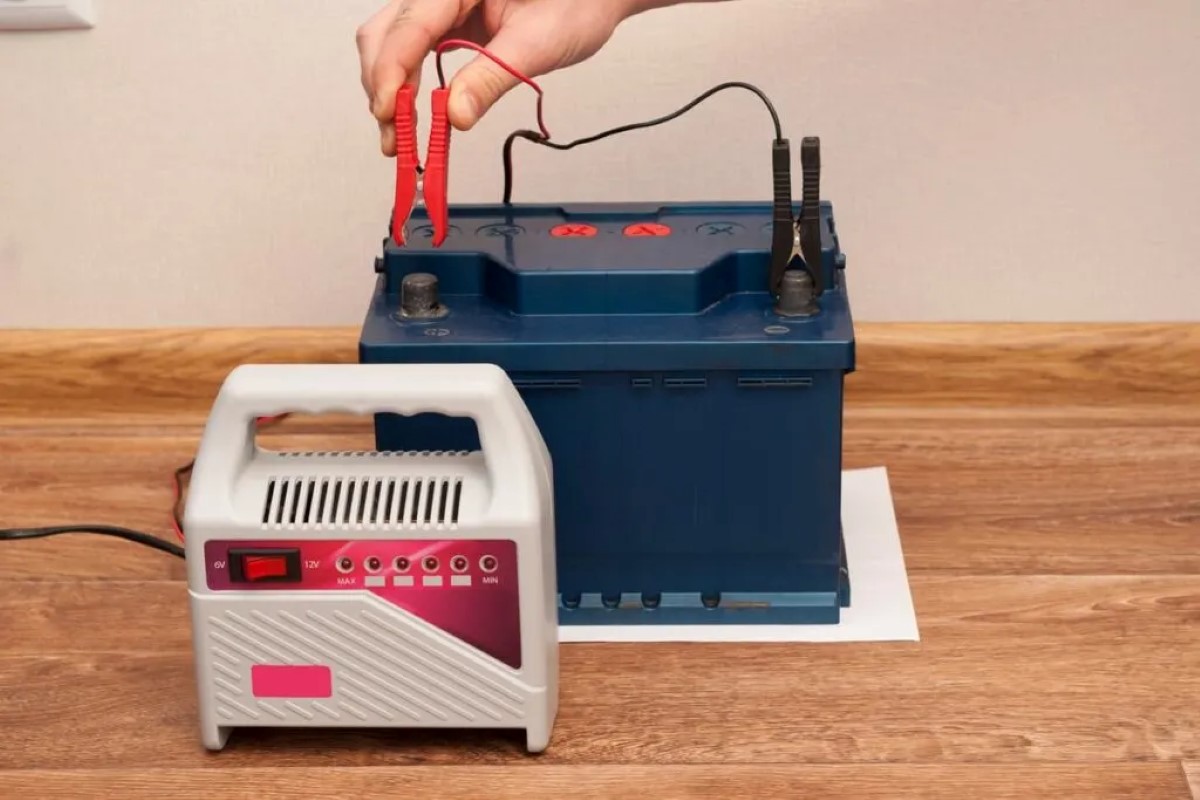

Articles
How To Store A Car Battery Long Term
Modified: January 7, 2024
Learn how to properly store a car battery for long-term use. Get expert tips and advice in this informative article.
(Many of the links in this article redirect to a specific reviewed product. Your purchase of these products through affiliate links helps to generate commission for Storables.com, at no extra cost. Learn more)
Introduction
Properly storing a car battery long-term is essential to ensure its longevity and optimal performance. Whether you are going on an extended vacation, have a seasonal vehicle, or simply want to store a spare battery, following the right storage practices can prevent damage and extend the lifespan of your battery.
A car battery is a crucial component that provides the necessary electrical power to start the engine and operate various electrical systems in the vehicle. However, if not stored correctly, a battery can become damaged, lose its charge, or suffer from corrosion and deteriorate over time.
In this article, we will guide you through the steps to store a car battery long-term effectively. By following these steps, you can ensure that your battery remains in good condition, reducing the risk of damage and maximizing its lifespan.
Key Takeaways:
- Properly storing a car battery long-term is crucial to prevent damage, maintain performance, and maximize lifespan. Follow the steps outlined to ensure your battery remains in optimal condition and ready for use when needed.
- Regularly checking the battery during storage allows for early detection of issues, ensuring optimal condition and reliable performance. Implement these storage practices to preserve your car battery for years to come.
Read more: How To Store A Battery Long Term
Importance of Proper Car Battery Storage
Properly storing your car battery is crucial for several reasons. Firstly, it helps to prevent the battery from losing its charge over time. If a battery is stored in an improper condition, its charge will gradually deplete, leaving you with a dead or weak battery when you eventually need to use it. This can be particularly problematic if the battery is stored for an extended period.
Secondly, storing your car battery correctly can prevent it from suffering from corrosion. Corrosion occurs when moisture and other contaminants come into contact with the battery terminals and lead to the buildup of acidic residue. This corrosion can hinder the battery’s performance and even lead to electrical issues in your vehicle.
Additionally, proper storage helps to protect the internal components of the battery from damage. Extreme temperatures, whether hot or cold, can have a detrimental effect on the battery’s overall health. By storing the battery in a controlled environment, you can minimize the risk of temperature-related damage and ensure that the battery will work optimally when you need it again.
Another important aspect of proper car battery storage is safety. Batteries contain highly corrosive substances and generate gases that can be potentially hazardous. By storing the battery in a suitable location and following the recommended storage guidelines, you can reduce the risk of accidents or injuries associated with mishandling the battery.
Lastly, proper storage can help prolong the lifespan of your car battery. By taking the necessary precautions, such as keeping it at the right temperature, preventing corrosion, and regularly checking its charge, you can help ensure that the battery remains in excellent condition and has a longer life expectancy.
Overall, proper car battery storage is vital to maintain the battery’s performance, prevent damage, and maximize its lifespan. By following the steps outlined in this article, you can confidently store your car battery long-term and have peace of mind that it will be ready for use when you need it next.
Step 1: Cleaning the Battery
Before storing your car battery long-term, it is essential to ensure that it is clean and free of dirt, debris, and corrosion. Cleaning the battery not only helps to maintain its appearance but also prevents the buildup of acidic residue that can lead to corrosion and electrical issues.
To clean the battery, start by disconnecting it from the vehicle following the manufacturer’s instructions. This step is crucial to ensure your safety and prevent any accidental electrical discharge during the cleaning process.
Next, visually inspect the battery for any signs of dirt, dust, or corrosion. Use a soft brush or an old toothbrush dipped in a mixture of baking soda and water to gently scrub the battery terminals and the surrounding area. The baking soda helps neutralize any acidic buildup and aids in removing stubborn corrosion.
After scrubbing, rinse the battery terminals and the surrounding area with clean water to wash away any residue. Be careful not to allow water to enter the battery itself, as it can damage the internal components.
Once the battery is clean, use a clean cloth to dry the terminals and the surrounding area thoroughly. It is essential to ensure that no moisture remains, as moisture can contribute to corrosion.
After cleaning and drying the battery, apply a thin layer of petroleum jelly or a battery terminal protector spray to the battery terminals. This protective coating helps to prevent further corrosion and maintain the conductivity of the terminals.
Remember to take proper precautions when cleaning the battery. Wear gloves and safety glasses to protect yourself from any corrosive substances or debris. If you notice any significant damage or excessive corrosion during the cleaning process, it may be a sign that the battery needs to be replaced.
By thoroughly cleaning the battery before storage, you are taking an important step to ensure that it remains in good condition and is ready for use when you retrieve it.
Step 2: Disconnecting the Battery
Once you have cleaned the battery, the next step in storing it long-term is to disconnect it from the vehicle. Disconnecting the battery serves two main purposes – it prevents any parasitic drain on the battery and ensures safety during storage.
Before disconnecting, it is crucial to consult your vehicle’s owner’s manual or seek guidance from a professional to understand the specific steps and precautions for disconnecting the battery in your particular vehicle model.
Start by turning off the ignition and all electrical systems in the vehicle. This ensures that there are no active connections that can draw power from the battery.
Next, identify the negative terminal and the positive terminal of the battery. The negative terminal is usually marked with a “-” symbol or is colored black, while the positive terminal is marked with a “+” symbol or is colored red.
Using a wrench or a socket, loosen the nut or bolt that secures the negative terminal connector. Carefully remove the connector from the battery terminal, taking care not to touch the positive terminal or any other metal surfaces with the wrench at the same time.
Repeat the same process for the positive terminal, loosening the nut or bolt and removing the connector from the battery terminal.
Once the battery terminals are disconnected, it is essential to prevent them from accidentally coming into contact with each other or any other metal surfaces. You can use electrical tape or terminal covers to cover the exposed terminals and minimize the risk of any accidental electrical discharge during storage.
It is crucial to store the battery terminals in a safe and dry location during the storage period. Do not place them on a conductive surface or near any flammable materials to reduce the risk of accidents.
By disconnecting the battery from the vehicle, you are preventing any parasitic drain and ensuring that the battery remains in optimal condition during storage. It is important to note that reconnecting the battery correctly when you retrieve it is equally important, so be sure to follow the proper steps to avoid any electrical issues.
Step 3: Removing Corrosion
Corrosion on the battery terminals can hinder the performance and lifespan of your car battery. Therefore, it is crucial to remove any existing corrosion before storing the battery long-term. Here’s how you can effectively remove corrosion from the battery terminals:
1. Start by putting on gloves and safety glasses to protect yourself from any corrosive substances.
2. Mix a solution of equal parts baking soda and water in a small container.
3. Dip an old toothbrush or a small wire brush into the baking soda solution.
4. Gently scrub the battery terminals and connectors with the brush. Pay special attention to areas with visible corrosion.
5. Continue scrubbing until the corrosion is loosened and removed from the terminals. You may need to apply firm but gentle pressure for stubborn corrosion.
6. Rinse the terminals with clean water to wash away any residue and baking soda solution. Be careful not to allow the water to enter the battery or any other electrical components.
7. Once the terminals are clean, dry them thoroughly with a clean cloth.
8. Apply a thin layer of petroleum jelly or a battery terminal protector spray to the terminals. This protective coating helps prevent future corrosion and ensures good conductivity.
If the corrosion is excessive or persistent, you may need to consult a professional or consider replacing the battery terminals. They can assess the extent of the damage and recommend the best course of action.
By removing corrosion from the battery terminals, you are improving the battery’s performance and reducing the risk of electrical issues. This step is particularly important for long-term storage, as it helps prevent further corrosion during the storage period.
To store a car battery long term, it’s best to keep it in a cool, dry place and periodically charge it to prevent it from losing its charge. Avoid storing it directly on concrete to prevent discharge.
Read more: How To Store A Car Long Term
Step 4: Checking the Battery’s Charge
Before storing your car battery long-term, it is essential to check its charge level. This step ensures that you store the battery with an optimal charge, minimizing the risk of it losing power during storage. Here’s how you can check the battery’s charge:
1. Put on gloves and safety glasses to protect yourself while handling the battery.
2. Use a digital multimeter to check the battery’s voltage. Set the multimeter to the DC voltage setting.
3. Locate the positive terminal and the negative terminal of the battery. The positive terminal is usually marked with a “+” symbol or is colored red, while the negative terminal is marked with a “-” symbol or is colored black.
4. Place the multimeter’s red probe on the positive terminal and the black probe on the negative terminal.
5. Read the voltage displayed on the multimeter. A fully charged battery should have a voltage reading of around 12.6 to 12.8 volts.
6. If the battery voltage is below the recommended level, it may need to be recharged before storage. Consult the battery manufacturer’s guidelines for proper charging procedures or consider using a battery charger to restore its charge.
7. If you don’t have access to a multimeter, you can also take the battery to a local auto parts store or a service center. They can perform a battery load test to determine its charge and overall health.
Storing a battery with a low charge can lead to self-discharge over time, leaving you with a weakened or dead battery when you need it again. By checking and ensuring a sufficient charge level before storage, you can prolong the battery’s life and have confidence that it will be ready for use when you retrieve it.
Step 5: Choosing the Right Storage Location
Selecting the proper storage location for your car battery is crucial to ensure its safety and longevity during the storage period. The ideal storage location should provide a controlled environment that minimizes exposure to extreme temperatures, moisture, and other potentially damaging factors. Here’s what to consider when choosing the right storage location:
1. Temperature: Car batteries should be stored in a cool, dry place. Extreme temperatures, whether hot or cold, can adversely affect the battery’s performance and lifespan. Avoid storing the battery in areas exposed to direct sunlight, such as near windows or outside buildings. Aim for a temperature range of around 50°F to 80°F (10°C to 27°C).
2. Moisture: Moisture can lead to corrosion and damage the battery’s internal components. Choose a storage location that is dry and well-ventilated. Avoid areas prone to high humidity, such as basements or areas with water leaks. If necessary, use a dehumidifier to maintain optimal humidity levels.
3. Security: Ensure that the storage location is secure and protected from potential theft or damage. If storing the battery in a garage or shed, make sure it is locked, and there is limited access to unauthorized individuals.
4. Stability: The storage location should provide a stable surface or shelf to prevent any accidental tipping or damage to the battery. Avoid storing the battery directly on cement floors, as they can draw moisture and contribute to corrosion.
5. Accessibility: Consider the accessibility of the storage location. You should be able to easily retrieve the battery when needed without any obstacles or difficulties.
6. Compliance: Ensure that the chosen storage location complies with any local regulations or guidelines regarding the storage of batteries or hazardous materials.
By selecting the right storage location, you can protect your car battery from potential damage and maintain its optimal condition during the storage period. Remember to follow all safety precautions and guidelines when handling and storing the battery.
Step 6: Storing the Battery
Proper storage of your car battery is crucial to maintain its condition and maximize its lifespan. When storing the battery, it is essential to take precautions that ensure its safety and prevent any damage. Here’s how to store your car battery correctly:
1. Clean and dry the battery: Before storing the battery, make sure it is clean and dry. Remove any dirt or debris and ensure that the terminals are free of corrosion. Use a cloth to dry the battery thoroughly to prevent the buildup of moisture.
2. Wrap the battery: Wrap the battery in a clean, dry cloth or place it in a battery storage case. This provides an extra layer of protection against dust and moisture and helps maintain the battery’s cleanliness during storage.
3. Choose a flat, stable surface: Place the battery on a flat, stable surface in an upright position. Avoid storing the battery on concrete floors, as they can draw moisture and contribute to corrosion.
4. Maintain a cool temperature: Store the battery in a location with a consistently cool temperature, ideally between 50°F to 80°F (10°C to 27°C). Extreme temperatures can negatively impact the battery’s performance and lifespan.
5. Avoid direct sunlight: Ensure that the storage location is away from direct sunlight. Prolonged exposure to sunlight can cause the battery to overheat and deteriorate over time.
6. Keep the battery away from flammable materials: Store the battery in a safe area, away from any flammable materials. This minimizes the risk of accidents or damage in case of a battery leak or electrical discharge.
7. Recharge if necessary: If the battery’s charge is below the recommended level, consider recharging it before storage. Follow the manufacturer’s instructions or use a quality battery charger to restore the charge to an optimal level.
8. Regularly check the battery: During the storage period, it is advisable to periodically check the battery’s condition. Inspect for any signs of corrosion, leakage, or damage. If any issues are detected, consult a professional or consider replacing the battery.
By following these storage guidelines, you can ensure that your car battery remains in good condition and is ready for use when you need it again. Proper storage not only safeguards the battery but also helps extend its lifespan, ensuring reliable performance in the long run.
Step 7: Regularly Checking the Battery
Regularly checking your car battery, even during storage, is essential to ensure its optimal condition and prevent any potential issues. By performing periodic checks, you can identify and address any problems promptly, ensuring that the battery remains in good health. Here’s how to effectively check your car battery during storage:
1. Frequency of checks: It is recommended to check the battery every one to three months during storage. This frequency allows you to monitor its condition and address any issues before they worsen.
2. Visual inspection: Start by visually inspecting the battery for any signs of damage, such as cracks, leakage, or bulging. If you notice any abnormalities, it may indicate a faulty or compromised battery that requires professional attention or replacement.
3. Check the terminals: Examine the battery terminals to ensure they remain clean and corrosion-free. If you notice any corrosion buildup, gently clean it using a battery terminal cleaner or a mixture of baking soda and water. Remember to wear gloves and safety glasses when handling corrosive substances.
4. Measure the voltage: Use a digital multimeter to measure the battery’s voltage. Set the multimeter to the DC voltage setting and connect the probes to the corresponding battery terminals – positive to positive, negative to negative. A healthy battery should have a voltage reading of around 12.6 to 12.8 volts. If the voltage is significantly lower, it may indicate a battery that requires recharging.
5. Recharge if necessary: If the voltage reading is below the recommended level, consider recharging the battery before continuing the storage period. Follow the manufacturer’s instructions or use a reliable battery charger to restore the battery’s charge to an optimal level.
6. Secure connections: Ensure that the battery terminals are securely connected and tight. Loose connections can cause electrical resistance and impact the battery’s performance. If necessary, tighten the terminal connectors using the appropriate tools.
7. Keep records: It is beneficial to keep a record of the battery’s condition and voltage readings throughout the storage period. This helps track any changes or trends, allowing you to identify any potential issues that may require further attention or battery replacement.
By regularly checking the battery during storage, you can detect any potential issues early on and take appropriate measures to maintain its optimal condition. This step ensures that the battery remains in good health and is ready for use when you retrieve it from storage.
Read more: How To Store A Car Outside Long Term
Conclusion
Properly storing your car battery long-term is crucial for maintaining its performance, preventing damage, and prolonging its lifespan. By following the steps outlined in this article, you can ensure that your battery remains in optimal condition during storage and is ready for use when needed.
From cleaning the battery and disconnecting it from the vehicle to checking its charge and choosing the right storage location, each step plays a vital role in preserving the integrity of your battery.
Regularly checking the battery’s condition and voltage during the storage period allows you to identify and address any issues promptly. This proactive approach minimizes the risk of battery failure and ensures that your battery remains in good health.
Remember to follow safety precautions throughout the entire process, wear protective gear, and consult your vehicle’s owner’s manual for specific instructions or seek guidance from a professional when needed.
Proper storage safeguards your battery against corrosion, moisture, extreme temperatures, and other potentially damaging factors. By taking the time and effort to store your car battery correctly, you can maximize its lifespan and save money by avoiding premature battery replacement.
Furthermore, a well-maintained battery ensures reliable performance when you need it, whether starting your vehicle after an extended time in storage or as a backup power source.
By implementing these storage practices, you can have confidence that your car battery will remain in excellent condition and be ready to power your vehicle or equipment when you retrieve it from storage.
So, follow these steps, take proper care of your car battery during storage, and enjoy the benefits of a well-preserved and long-lasting battery for years to come.
Frequently Asked Questions about How To Store A Car Battery Long Term
Was this page helpful?
At Storables.com, we guarantee accurate and reliable information. Our content, validated by Expert Board Contributors, is crafted following stringent Editorial Policies. We're committed to providing you with well-researched, expert-backed insights for all your informational needs.














0 thoughts on “How To Store A Car Battery Long Term”